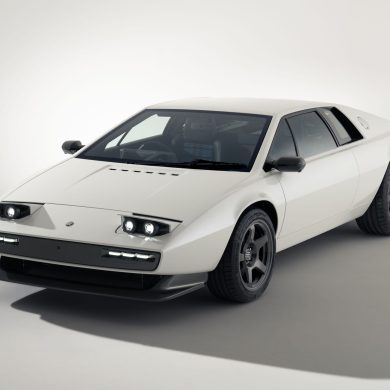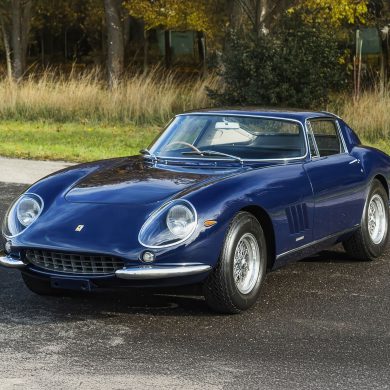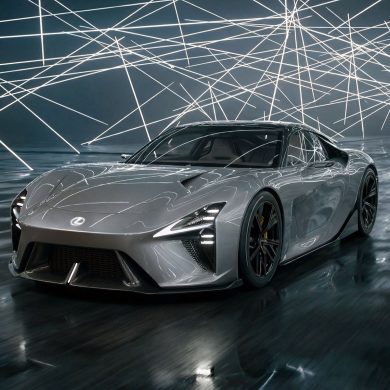Story by Will Silk

The years spanning 1941-1945 were consumed by World War 2, but Lyons was anxious to return to building cars once hostilities came to an end. With the “SS” name discontinued due to its infamous use by Nazi Germany, Lyons selected the name Jaguar and proceeded to carry on operations. The first post war Jaguar of a sporting nature was the XK120, which debuted in 1948. The “XK” represented the marvelous duel over head cam six cylinder engine, with 160 horsepower on tap to propel the XK120 to 60mph in 10 seconds and ultimately to a top speed of 120mph, which was represented in the car’s title by the last three digits. Privateer operated XK120s would first see action at Le Mans in 1950, finishing as high as 12th place overall.
The C-Type would debut with spectacular results upon its first outing at the French classic, with the Peter Walker and Peter Whitehead duo winning in grand fashion that summer weekend in 1951. The sleek cats from Coventry would return with an all out factory backed effort for 1953 which would see Tony Rolt and Duncan Hamilton take 1st overall followed across the line by the Moss/Walker car for a British Racing Green one-two!

The C-Type’s success at Le Mans was helping Lyons sell his stately saloon cars, all of which benefited from lessons learned from racing for 24 hours in France. The C-Type’s 200 horsepower 3.4L “XK” engine and tubular space frame were cutting edge prototype technology in 1953. However, technology was evolving quickly at Browns Lane in the early 1950s, and this evolution spawned the incredible D-Type.
The D-Type moved into the realm of light-weight alloy monocoque chassis construction and took advantage of engine tuning that was developed during the C-Type campaign. The D-Type also broke into a new world of brake technology, using Dunlop developed disc brakes which quickly gave the green cats an edge at the far end of the Mulsanne Straight where the D-Type would be entering the brake zone at over 160mph.

While Tony Rolt and Duncan Hamilton managed a fine 2nd place for Jaguar in the D-Type for the 1954 race; the D-Type would return and win in 1955, 1956, and 1957! After 1957’s win in the hands of the legendary Ecurie Ecosse Racing Team, Jaguar would settle in to producing fine, road-going sports cars and saloons, leaving the cat’s racing efforts to privateers throughout the 1960s and 1970s.
The 1980s would see an awakening of the beast from Brown’s Lane, first in privateer form, and by the latter 1980s in full factory trim once more. Having grown board with Porsche’s dominance of the French Classic, Jaguar was assisting Group 44 Racing in America in a new series run by IMSA called GTP. The Group 44 XJR-5 was a mid-engine, closed cockpit, sports prototype with a mighty 6.0L V-12 Jaguar engine mounted amid ship. Headed by the legendary driver/team owner Bob Tullius, and with an incredible driver line up including Tony Adamowicz, Brian Redman, and John Watson; the 1984 Group 44 Jaguar effort looked unstoppable. Both entries eventually retired with gearbox problems, but while they were running they provided Porsche and Lancia with a surprising fight, as Redman even led the race early on. Tullius would recover for 1985 by finishing 13th overall.
The efforts of Group 44 would set the stage for Jaguar to partner with Silk Cut and return for the rest of the decade. Jaguar Sport would be formed in conjunction with Tom Walkinshaw Racing (TWR) and along with sponsorship provided by Silk Cut cigarettes, Jaguar would see two more 24 Hour of Le Mans victories added to their tally with the Lammers, Dumfries, and Wallace XJR-9LM winning in 1988 and the Nielsen, Cobb, and Brundle XJR-12 securing Jaguar’s seventh overall win in 1990.

Jaguar Celebrates 75 Years with Le Mans Return – Photo Gallery Page Two
Yet, the cat that has slept for the last 20 years has recently announced it will return to Le Mans with a single entry for the 2010 running of the French Classic this June. The Jaguar RSR XKR GT2 will be the lone cat to take the fight to some of the best teams in GT racing the world has ever seen assembled in one place. The competition will include the seasoned Chevy Corvette squad fielding two C6R machines, as well as a Spyker, and a throw back to the good ole days, a lone Aston Martin entry. Paul Gentilozzi and Scott Pruett, both American, will be piloting the XKR GT2 along with Marc Goossens of Belgium.
Gentilozzi comments, “We are delighted the ACO has granted us entry in the prestigious 24 hours of Le Mans. It is a race that is held dearly in the hearts of motorsport fans across the world and for Jaguar to be racing again is something special. Spirits will be high around Jaguar’s return to Le Mans but we must remember the incredibly high level of competition – a podium place in our category will not fall into our hands. That said, I can guarantee 100 per cent commitment from Jaguar RSR and urge fans of Jaguar and Britain’s racing heritage to support the team whole heartedly.”
Global Marketing Director of Jaguar Cars C.J. O’Donnell adds, “Motorsport has always been important to the Jaguar brand. Our domination of Le Mans in the 1950s was a foundation on which the company was developed. It was twenty years ago that Jaguar last won Le Mans with a TWR Jaguar Sport entry driven by John Nielsen, Price Cobb and Martin Brundle. Returning to Le Mans will reignite excitement for the marque across the globe, all the more poignant in our 75th year.”

With Jaguar’s history of assembling teams with a stunning reputation of preparing immaculate cars that can go the distance for 24 hour drives through the scenic French country side, it is certain that this lone XKR GT2 will possess the potential to deliver Britain’s most iconic auto maker what could be the best birthday gift yet, an epic eighth win at the Le Mans 24 Hours Race.
In addition to competing at Le Mans, Jaguar will celebrate its 75th anniversary at many of the premier automotive settings, including the Goodwood Festival of Speed and Revival, Pebble Beach Concours D’Elegance and Mille Miglia Storica.
Jaguar 75th Anniversary Photo Gallery (click image for larger picture)










So nice!! 🙂
Greetings Will,
Unfortunately this “anniversary” is just a marketing ploy.
SS Cars did go public but I believe it the SS100 already was in existence and those cars had SS cast into their engine block as Standard still provided the engine and chassis at the time.
If this is to be taken seriously then by Jaguar’s own definition the anniversary would be celebrating a car that was bodied by SS and chassis built by Standard.
Some could even say this was the “first” time Jaguar “badge-engineered” a car, a feat they later attempted using the Ford Mondeo chassis.
Your article was well written but all the books detailing Ss and Jaguar’s history must be either in error or Jaguar has some very interesting criteria in what constitutes a “Jaguar”.
If Jaguar calls it their anniversary – marketing ploy or not – then it must be their anniversary. Neat article and great pictures.
“If Jaguar calls it their anniversary – marketing ploy or not – then it must be their anniversary.”
And I’m God… :rolleyes:
“The years spanning 1941-1945 were consumed by World War II…”
For Americans, yes, but Britain was fighting the Germans from September 1939, with the Battle of Britain raging in the skies over Southern England during 1940. So Bill Lyons’ factory would have been producing war materiel, not SS100’s or Jaguar’s.
Hi John,
The text you quoted from my article is indeed an error in reference to the British involvent in the Second World War. My apologies.